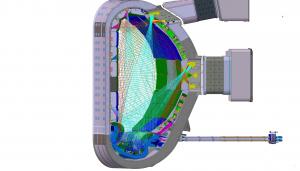Diagnostics for maintaining the power balance
To maintain the optimal power balance in the ITER Tokamak, the plasma control system needs to know not only how much heat is coming out, but also which of the possible ways it is coming out: conduction and convection, electromagnetic radiation—or through neutrons. The goal is to reduce conduction and convection heat, and increase radiated heat, to the point that 90 percent of the power loss (not counting the neutrons) is electromagnetic radiation.
Electromagnetic radiation heat has the advantage that, like the neutrons, it dissipates over a wider area in the tokamak (over 800 square metres) as opposed to conduction and convection heat, both of which concentrate their heat mostly on the divertor (an area of less than 100 square metres).
"One difficulty in maintaining the right percentage of radiated power is that the closer you get to this 90 percent goal, the higher the risk of going up to the 100 percent line, which would lead to a radiative collapse of the plasma," says Roger Reichle, Ex-Vessel Diagnostics Section Leader. "Bolometers¹ allow us to walk this fine line: not only do they measure the total amount of radiation with good precision, but they also measure the radiation pattern, which uniquely identifies the different operating conditions."
The bolometers deliver these observations to the plasma control system, which can then initiate any necessary adjustments. If radiation heat is below 90 percent, the control system may pump more impurities into the plasma to increase radiation. If it is above 90 percent, it may either reduce the impurities or increase the heat input through external heating.
Bolometers were invented nearly 150 years ago, and have since been applied in a number of domains—for example in astronomy to detect very faint changes in radiation. A basic bolometer consists of a thin strip of metal that absorbs radiation and heats up. The resistance of the metal strip is then measured to determine how much radiation has been absorbed.
The bolometers ITER will use are miniaturized metal resistor bolometers. Thin film metal absorbers (up to 20 µm thick), deposited on top of very fine membranes (3 - 25 µm thick, depending on the substrates and manufacturing techniques) capture integrally the light emitted by the plasma over most of the relevant spectral range (from the near infrared to the soft x-ray range). A meander-shaped metal conductor on the backside measures temperature changes through changes in electrical resistance. To compensate for changes in ambient conditions, two absorbers will operate jointly in a bridge circuit, with one of the absorbers shielded from the plasma radiation to serve as reference (heated by the environmental heat—a combination of nuclear radiation and ambient temperature).
One of the more demanding requirements on the ITER bolometers is that they must provide data readings within 1 millisecond. This drives the design towards thin membranes, which have lower heat transfer time. Another distinction is that ITER bolometers have to be robust enough to operate in a vacuum with high neutron fluxes and ambient temperatures exceeding 200 °C. They have to withstand a number of loads, including seismic loads and water and steam ingress due to water leaks, electromagnetic loads and associated forces during disruptions, and pressure pulses from massive gas injections to mitigate disruptions. These robustness requirements generally drive the design towards thicker membranes.
To get a complete picture of the radiation profile, the arrangement of bolometers is optimized for tomographic reconstruction using around 500 lines of sight crisscrossing the plasma in a very well-thought-out pattern to obtain the best possible tomographic image of the radiation.
"What we do is called sparse data tomography," says Reichle. "This is sufficient for us, because we only want to know about four or five features—and we know what the degrees of freedom are. Since the plasma flows along magnetic flux lines, we know that there will be relatively little change of radiation intensity in the direction of flux lines, but significantly more variation may occur perpendicular to these flux lines. Similarly, in the divertor region, the local variations can be significantly higher than in the bulk of the plasma and we have to detect the details there, which is the reason the highest concentration of lines of sight is in the divertor. It's a bit of an art to do tomography with so few lines of sight."
Essential calibration procedures
Sparse data tomography is not the only area that calls for an artistic hand. Keeping the bolometers operating during a 30-minute pulse and then re-calibrating them for the next experiment will also require a delicate touch.
"One challenge is that during operation of the machine, the heat generated during an experiment will cause the environment to heat up," says Hans Meister of the Max Planck Institute for Plasma Physics, project leader of the consortium that designs the ITER bolometer. "So we'll have to determine before every plasma discharge the temperature-dependent calibration parameters to avoid any long-term slow drift. Fortunately, though, the calibration procedure is straightforward. We just send a specific amount of electrical voltage onto the resistors, which heats up the absorber. The resulting exponential decay of the temperature of the absorber, measured by the resistance underneath, makes it possible to determine the calibration constants of the bolometers."
"However the long discharge times in ITER also result in temperature changes of the environment in between calibrations and thus call for additional measures," Meister points out. "Recording not only the voltage but also the current through the bridge circuit enables us to devise the required schemes for calculating the temperature changes and compensations for the change in calibration parameters."
¹ A bolometer (from the ancient Greek ballein, to throw, to send) is a device for measuring the power of incident electromagnetic radiation via the heating of a material with a temperature-dependent electrical resistance.



